Once upon a time, a skincare routine consisted of washing your face, patting it dry, and you’re all done. Nowadays, a splash of water doesn’t cut it.
Bringing up the topic of skincare routines in conversation, the group will instantly transform into scientists, all declaring how they follow a strict multi-step routine. You’ll be bombarded with products such as cleansers, toners, exfoliators, and serums, including ingredients like bakuchiol, retinol, niacinamide and hydrochloric acid. But it doesn’t stop there: you have skincare routines for normal skin, dry skin, and oily skin, each requiring different products and applications. There is even a difference between your evening and morning skin routine. And don’t get me started on which vitamins you need!
And what is this for? Soft, plump, youthful-looking skin with no sign of a bump or blemish.
With so many products and brands to choose from, the skincare market is facing an issue we call choice paralysis. Customers diagnosed with choice paralysis will show symptoms of stress, confusion, and frustration whenever they take on the mentally taxing buying journey to find a skin care product that works.
Choice paralysis, also known as choice overload or the paradox of choice, is a particular problem for beauty retailers, as it can make customers feel overwhelmed, leading to poor decisions and a dissatisfying user experience. Even after a customer pays for products included in their expensive, multi-step routine, there is no guarantee that they will achieve the perfect complexion they see in Reels.
Beauty retailers rely heavily on their customers to research the products that work best for them. However, advice and guidance from influencers on TikTok can skew their understanding and pass on misinformation, some of which could even damage their skin.
Through the clouds of skin care products and piles of information, a retailer sits on a mission to provide a user experience that is simple to follow, stress-free, and will provide their customers with a skincare solution the first time around. This brand is Face the Future.
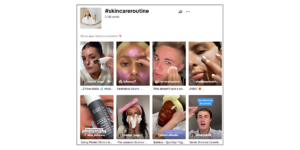
Who is Face the Future?
Face the Future is a retailer on the rise. The Salience Beauty Retailers report found that the brand has had a 26% increase in traffic to its website since 2022 and a monthly average of 8,100 brand-related searches. It is within the top 5 best-reviewed beauty retailers across the whole market, and data from Ahrefs suggests that it is a brand growing consistently, now receiving over 52,000 visitors on average per day.
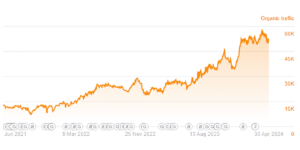
Face the Future is generating such growth because it minimises the effects of choice overload, something the majority of the beauty industry needs to catch up on. They are doing this in two ways: we have unpacked how and explained why this works so well in providing customers with a clear resolution for their skin care needs.
Honing down on trust to help customers feel satisfied with their purchase decisions
When you click on Face the Future, its branding strategy is very clear. With images of people in medical scrubs and quotes from dermatologists and skin experts, customers instantly feel as though the recommendations on this site will be correct.
This is an essential factor for online retailers. Although not a ranking factor, Google expresses the importance of producing high-quality content for medically-related websites under Your Money, Your Life. YMYL topics must be accurate, well-informed and aligned with the most up-to-date research.
Face the Future has created a brand reputation that positions them as experts. Their content focuses on their visitors’ problems and aims to provide solutions. They use authority figures, such as in this article by Dr Derrick Phillips, to help readers understand the issues you may have with your skin and what products can be used to prevent any further damage. They even have articles written from the first-person perspective of their staff, like this article by a practitioner at Face the Future, who speaks about her acne skincare journey.
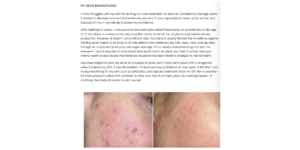
This content isn’t designed to rank with high-volume keywords; it has been produced to help its customers. Alongside images of real skin problems, Face the Future uses an empathetic tone throughout its content, showing an understanding of its customers’ problems and a humanistic approach to solving them.
Through building trust, once a customer is on a product display page, they use the trust they have built beforehand to suggest who the product is for and why it will work. Take this one for a cleansing gel.
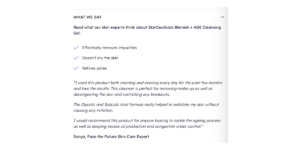
Using a quote from a staff member at Face the Future shows that the retailer has tested the products for themselves and is only selling products that work. Because Face the Future has built trust throughout the user journey, customers are likelier to believe this information. A link to an author bio would finish the job perfectly.
Educating customers at points where they need it most to help make informed decisions
Face the Future recognises that people need information when choosing a skin care product, let alone creating a routine. However, where competitors in the industry rely on customers already knowing what they want, Face the Future ensures customers have the correct information to make an informed purchase decision.
Starting in the top navigation bar, the ‘Advice For Life’ section provides all the necessary information before you purchase a product. It helps you understand how the skin works and provides an overview of basic skincare. This information is located in the Skin Hub and includes a basic routine for users to follow, depending on their skin type and needs.
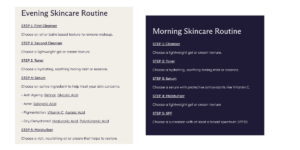
This is followed by a skincare ingredients glossary, which gives customers a handy definition guide for all those new, scientific terms.
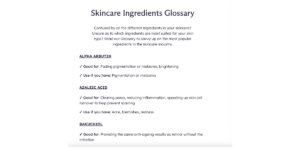
But they don’t stop there. On product listing pages, Face the Future reminds customers of the information they need before they browse, explaining what the product is, what it is best for, and the expected outcome of using it. This information is all within the top copy.
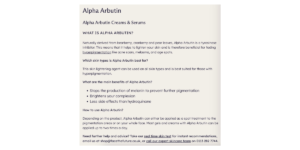
There are no links to guides or a sales pitch to make you buy. This page provides simple, straight-to-the-point information that helps customers understand whether the products on this page will solve their issues.
As if that weren’t enough, Face the Future actively encourages its customers to speak to one of its skin care experts through a free consultation or a simple phone call.
Taking a look at Face the Future’s PLPs educate and allow the customer to filter down the products, and once they have done that, they can choose from a smaller selection of products.
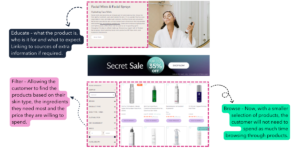
Compared to the high street brands and popular online beauty retailers, this extra bit of information, before the user starts browsing, will remind and usefully inform the customer what they need when they need it.
How do trust and helpful content minimise the effect of choice paralysis?
When customers lack knowledge about a specific range of products, they can feel overwhelmed when visiting a website offering hundreds of products from various brands and, therefore, use mental shortcuts to make decisions. To combat choice paralysis and minimise the cognitive load on decision-making, it’s important to provide helpful content and build a layer of trust with customers. This approach can mitigate two prominent mental shortcuts: the Einstellung and Ambiguity effect.
The Einstellung Effect
Coming from the German for ‘attitude’, the Einstellung effect is a cognitive bias shoppers experience when they use existing experiences to approach a new problem. By using existing attitudes and beliefs, they miss out on alternative solutions that could bring about better outcomes.
When shopping for skincare products, customers are likely to purchase the products they have used before or that they are aware of, even though there are better options. This is particularly true if they have developed new skin conditions and even more so when they have too many options to look through.
Let’s say someone struggles with acne and has used a group of products before that helps but doesn’t completely clear their skin; they will base any new product they use on the one with some positive effects. However, if they use a new product or change their routine, the fear that it worsens their acne can sway their decision.
A website can reduce customers’ anxiety when purchasing skincare products by building trust through branding and content. This is precisely what Face the Future has done. They have understood that their customers have more severe skin concerns and have ensured that they are emphatic and understanding with the customer throughout the journey. This leads to customers feeling more confident in the solutions that Face the Future proposes.
The Ambiguity Effect
The ambiguity effect occurs when shoppers need more information about a product. Shoppers dislike uncertainty and are only willing to part ways with their money if they are convinced the product will do the job. When this occurs, shoppers are more likely to select a product where the probability of it working is known, even if it is not the best solution.
With so many options in skincare, someone seeking a solution will want to choose one they are confident in working with and, more importantly, will not make their skin condition any worse. This bias can be solved through social proofing and reviews, but the other is through plenty of helpful content.
Face the Future has honest reviews of its products, and customers can read these to find opinions. But by providing helpful content and ensuring customers understand how the products work, what the expected outcome is, whether or not it is suitable for them, and what each of the ingredients does, customers will feel more informed and patch up any spots of uncertainty when making a decision. This is vital when browsing through products and brands they may have not heard of or seen.
What can brands learn from Face the Future?
The cognitive load of making a purchase decision can be demanding, even more so when it affects your well-being and is within a product category that can be complex. Brands must consider their target audience and understand their level of knowledge and how they come to make purchase decisions. Face the Future has done an excellent job at this; amongst other branding and customer retention strategies, they minimise the effect that choice paralysis can have through trust signals and effective content. Although the customer still has a little work to do to compare between products, they can get to that part of the buying journey sooner with less ambiguity, providing them with more confidence and direction to choose the right product.
If you are a brand in the skincare market and are looking to upscale your digital marketing efforts, contact the team at Salience and claim a free site audit.
